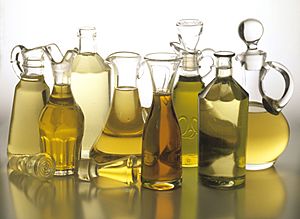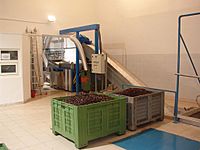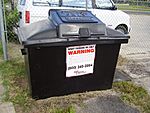Cooking oil facts for kids
Cooking oil is plant, animal, or synthetic fat used in frying, baking, and other types of cooking. It is also used in food preparation and flavouring not involving heat, such as salad dressings and bread dips, and in this sense might be more accurately termed edible oil.
Cooking oil is typically a liquid at room temperature, although some oils that contain saturated fat, such as coconut oil, palm oil and palm kernel oil are solid.
There are a wide variety of cooking oils from plant sources such as olive oil, palm oil, soybean oil, canola oil (rapeseed oil), corn oil, peanut oil and other vegetable oils, as well as animal-based oils like butter and lard.
Oil can be flavoured with aromatic foodstuffs such as herbs, chillies or garlic.
Contents
Health and nutrition

A guideline for the appropriate amount of fat—a component of daily food consumption—is established by regulatory agencies like the Food and Drug Administration. The recommendation is that 10% or fewer of daily calories should be from saturated fat, and 20-35% of total daily calories should come from polyunsaturated and monounsaturated fats.
Mayo Clinic has highlighted certain oils that are high in saturated fats, including coconut, palm oil and palm kernel oil. Those having lower amounts of saturated fats and higher levels of unsaturated (preferably monounsaturated) fats like olive oil, peanut oil, canola oil, soy and cottonseed oils are generally healthier.
The US National Heart, Lung and Blood Institute urged saturated fats be replaced with polyunsaturated and monounsaturated fats, listing olive and canola oils as sources of healthier monounsaturated oils while soybean and sunflower oils as good sources of polyunsaturated fats. One study showed that consumption of non-hydrogenated unsaturated oils like soybean and sunflower are preferable to the consumption of palm oil for lowering the risk of heart disease.
Peanut oil, cashew oil and other nut-based oils may present a hazard to persons with a nut allergy.
Trans fats
Unlike other dietary fats, trans fats are not essential, and they do not promote good health. The consumption of trans fats increases one's risk of coronary heart disease by raising levels of "bad" LDL cholesterol and lowering levels of "good" HDL cholesterol. Trans fats from partially hydrogenated oils are more harmful than naturally occurring oils.
Several large studies indicate a link between the consumption of high amounts of trans fat and coronary heart disease, and possibly some other diseases. The United States Food and Drug Administration (FDA), the National Heart, Lung and Blood Institute and the American Heart Association (AHA) all have recommended limiting the intake of trans fats.
Cooking with oil
Heating an oil changes its characteristics. Oils that are healthy at room temperature can become unhealthy when heated above certain temperatures, so when choosing a cooking oil, it is important to match the oil's heat tolerance with the temperature which will be used. Deep-fat frying temperatures are commonly in the range of 170–190 °C (338–374 °F), less commonly, lower temperatures ≥ 130 °C (266 °F) are used.
Palm oil contains more saturated fats than canola oil, corn oil, linseed oil, soybean oil, safflower oil, and sunflower oil. Therefore, palm oil can withstand deep frying at higher temperatures and is resistant to oxidation compared to high-polyunsaturated vegetable oils. Since about 1900, palm oil has been increasingly incorporated into food by the global commercial food industry because it remains stable in deep frying, or in baking at very high temperatures, and for its high levels of natural antioxidants.
The following oils are suitable for high-temperature frying due to their high smoke point above 230 °C (446 °F):
- Avocado oil
- Mustard oil
- Palm oil
- Peanut oil (marketed as "groundnut oil" in the UK and India)
- Rice bran oil
- Safflower oil
- Semi-refined sesame oil
- Semi-refined sunflower oil
- Olive oil
Storing and keeping oil
All oils degrade in response to heat, light, and oxygen. To delay the onset of rancidity, a blanket of an inert gas, usually nitrogen, is applied to the vapor space in the storage container immediately after production – a process called tank blanketing.
In a cool, dry place, oils have greater stability, but may thicken, although they will soon return to liquid form if they are left at room temperature. To minimize the degrading effects of heat and light, oils should be removed from cold storage just long enough for use.
Refined oils high in monounsaturated fats, such as macadamia oil, keep up to a year, while those high in polyunsaturated fats, such as soybean oil, keep about six months. Rancidity tests have shown that the shelf life of walnut oil is about 3 months, a period considerably shorter than the best before date shown on labels.
By contrast, oils high in saturated fats, such as avocado oil, have relatively long shelf lives and can be safely stored at room temperature, as the low polyunsaturated fat content facilitates stability.
Types and characteristics
Cooking oils are composed of various fractions of fatty acids. For the purpose of frying food, oils high in monounsaturated or saturated fats are generally popular, while oils high in polyunsaturated fats are less desirable. High-oleic acid oils include almond, macadamia, olive, pecan, pistachio, and high-oleic strains of safflower and sunflower.
Smoke point
The smoke point is marked by "a continuous wisp of smoke." It is the the temperature at which an oil starts to burn, leading to a burnt flavor in the foods being prepared and degradation of nutrients and phytochemicals characteristic of the oil. Above the smoke point are flash and fire points. The flash point is when the oil vapors will ignite but aren't produced in sufficient quantities to stay lit. The flash point generally occurs at about 275–330 °C (527–626 °F). The fire point is the temperature at which hot oil produces sufficient vapors it will catch on fire and burn. As frying hours increase, all these temperature points decrease. They depend more on an oil's acidity than fatty-acid profile.
The smoke point of cooking oils varies generally in association with how an oil is refined: a higher smoke point results from removal of impurities and free fatty acids. They also depend on any residual solvent remaining from the refining process. They have been reported to increase with the inclusion of antioxidants (BHT, BHA, and TBHQ). For these reasons, the published smoke points of oils may vary.
Oils are extracted from nuts, seeds, olives, grains or legumes by extraction using industrial chemicals or by mechanical processes. Expeller pressing is a chemical-free process that collects oils from a source using a mechanical press with minimal heat. Cold-pressed oils are extracted under a controlled temperature setting usually below 105 °C (221 °F) intended to preserve naturally occurring phytochemicals, such as polyphenols, plant sterols and vitamin E which collectively affect color, flavor, aroma and nutrient value.







 In Spanish:
In Spanish: